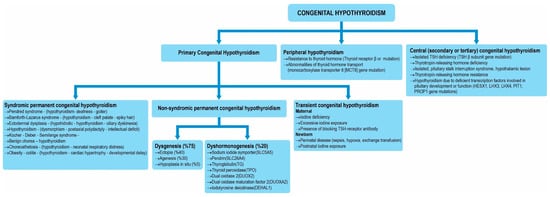Patients with positive screening results are evaluated according to their medical history, physical examination results, and laboratory findings. During the diagnostic process, thyroid function tests (FT3, FT4, TSH, thyroglobulin, and thyroid antibodies), scintigraphy and then USG should be performed under optimal conditions before or within 1 week after starting treatment [1,5,35]. Serum thyroglobulin levels provide information about the etiology of congenital hypothyroidism. Serum thyroglobulin levels close to zero suggest thyroid agenesis, low levels suggest thyroid hypoplasia, and high levels suggest dyshormonogenesis.
The clinical manifestations of congenital hypothyroidism (CH) are not obvious at birth, and most newborns are undiagnosed [1,2,3,4,5]. The main reason for this uncertainty is the protective effect of maternal T4 passing through the placenta to the infant. Approximately 50% of the T4 in cord blood is maternal in origin [1,2,3,4,5]. In addition, most infants with CH, except those with thyroid agenesis, produce low levels of T4. Thus, overt clinical symptoms develop slowly, which emphasizes the importance of diagnosis by screening tests and the initiation of treatment within the first two weeks. On the other hand, it is possible for infants with CH not to undergo screening tests. Therefore, overlooked clinical signs can lead to irreversible neurological damage. Omer Tarim et al. published the largest series of congenital hypothyroidism cases with delayed diagnosis in the literature before the implementation of newborn thyroid screening tests in Turkey [38]. The mean age at diagnosis was 49.22 months. All 1000 patients who were diagnosed with congenital hypothyroidism between 1972 and 1992 had delayed mental development. More than half (55.4%) of these patients were diagnosed after the age of two, and 3.1% of them were diagnosed during the neonatal period. The presenting complaints were delayed growth in 26.7% of the patients, inability to speak in 21.4% of the patients and inability to walk in 18.1% of the patients [38]. According to the clinical symptoms and findings, hypotonia was detected in 72% of the patients, constipation was detected in 66.8% of the patients, and cretinoid faces and macroglossia were detected in 64.6% of the patients. Some patients with delayed diagnosis exhibit hypotonia and die before diagnosis [38]. In addition, increased lumbar lordosis is a sign of hypotonia. Although 64.6% of these patients had a cretinoid face, some patients may not have this characteristic feature. These patients can be diagnosed through congenital screening programs. Babies with CH have a normal weight and height at birth, but their head circumference may be slightly greater [1,2,3,4,5]. They have large anterior and posterior fontanelles, and observation of this parameter at birth may be the first sign for early diagnosis of congenital hypothyroidism. Only 3% of normal newborn babies have a posterior fontanelle larger than 0.5 cm. Therefore, serum thyroid stimulating hormone (TSH) and free T4 (FT4) levels should be measured in babies born with a large posterior fontanelle [1,2,3,4,5]. To eliminate the possibility of central hypothyroidism, thyroid function tests should be performed for every baby whose neonatal jaundice is prolonged for more than 3 weeks. In addition, TSH may increase at a later stage in low birth weight babies. Serum FT4 and TSH measurements should be performed in babies with a history of excessive sleep (lethargy), feeding difficulties and constipation and in babies with an umbilical hernia, cold and mottled skin appearance, large fontanelle, rough face, large tongue, coarse-muffled crying, hypotonia, or a goiter detected on physical examination. However, a detailed examination of patients with cogenital hypothyroidism should be performed, especially to detect concomitant cardiac anomalies and dysmorphic findings [1,2,3,4,5]. The presence of thyroid disease, goiter or a known genetic disease in the family, especially in mothers and in cases of consanguineous marriages, should be considered. Transient neonatal hyperthyrotropinemia in the sibling and a history of autoimmune thyroiditis in the mother may indicate the presence of blocking antibodies.
Knee radiography is not a method used in the diagnosis of congenital hypothyroidism. The absence of femoral and tibial epiphyses detected on direct radiographs indicates the severity of intrauterine hypothyroidism [1,2,3,4,5]. On the basis of the ossifications detected in normal knee radiographs, the distal femoral epiphysis formed at 36 weeks, and the proximal epiphysis of the tibia formed at 38 weeks of gestation. In normal term newborns, two ossification centers should be located in the knee. Hand radiography was performed starting at 3 months of age.
The diagnosis of congenital hypothyroidism is based on the detection of increased serum TSH and decreased serum T4 and FT4 levels [39]. If the results of serum thyroid function tests do not match the clinical findings of patients, the possibility of interference/artifacts should always be considered [37,39]. In a study evaluating term infants with congenital hypothyroidism, thyroid scintigraphy performed before the start of treatment allowed for the early diagnosis of patients with ectopic hypothyroidism and agenesis and provided more information about permanent hypothyroidism [40]. The serum TSH level at diagnosis and the mean levothyroxine dose during treatment provide information about permanent hypothyroidism [33]. Serum FT4 and TSH levels should be obtained from patients with abnormalities detected in newborn screening tests (Figure 3). Thyroid scintigraphy should be performed in patients with laboratory and clinical findings of hypothyroidism (Figure 3) [36]. In newborns, iodine-123 (I-123) or sodium pertechnetate 99 m (Tc99m) thyroid scintigraphies are preferred. The iodine 131 (I-131) uptake test is generally not preferred because it exposes the thyroid gland and body of the infant to high doses of radioactivity. Thyroid scintigraphy reveals ectopia or agenesis in the thyroid gland.
When thyroid agenesis is detected via thyroid scintigraphy, the presence of TSH receptor inactivating mutations, thyroid stimulating hormone subunit beta (TSHB) gene mutations, iodine retention defects and maternal thyrotropin receptor blocking antibodies should be considered. The increased retention of radioactive iodine activity in the thyroid tissue and increase in thyroid size detected via thyroid scintigraphy may be one of the causes of dyshormonogenesis other than iodine retention defects. In accordance with the results of the thyroid scintigraphy, ultrasound, and measurement of serum thyroglobulin levels should be performed (Figure 3). The combined use of thyroid scintigraphy and thyroid ultrasound helps elucidate the etiology of congenital hypothyroidism. Transient congenital hypothyroidism, TSH receptor defects, or iodine blockade are diagnosed on the basis of the results of ultrasonographic tests and measurements of serum thyroglobulin levels (Figure 3) [21].
Source link
Hüseyin Anıl Korkmaz www.mdpi.com


